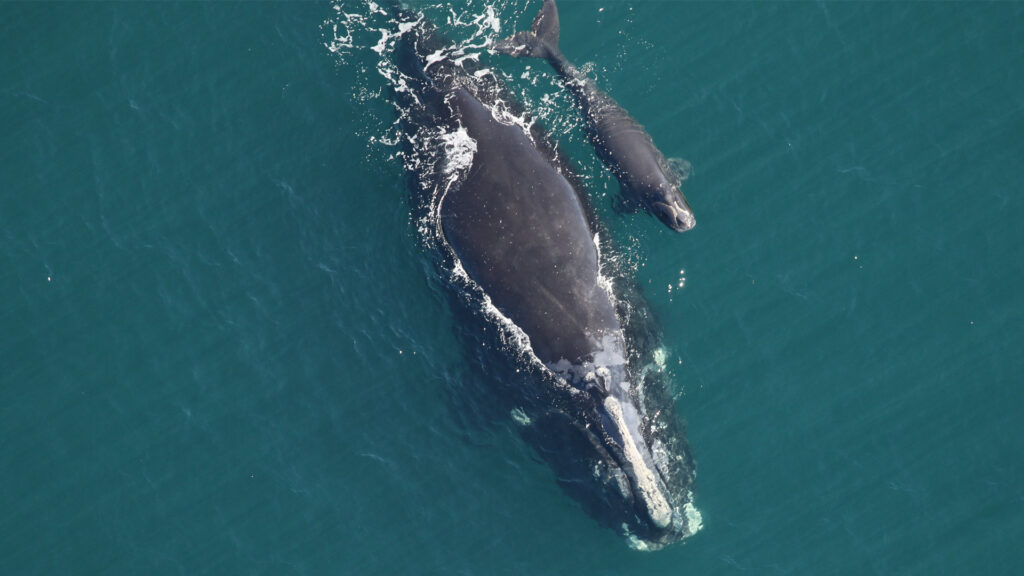By Hunter Miller, Oceana
Being a sixth-generation Floridian doesn’t afford me any special privileges, discounts or special badges that I could proudly display on my T-shirt as I peruse the Saturday farmer’s market. But it does and will always fill me with a deep connection and sense of responsibility to protect the natural treasures that have shaped my community and our collective heritage.

One such natural treasure is the iconic North Atlantic right whale.
The North Atlantic right whale holds a special place in the hearts of Floridians, and for good reason. These dark, stocky (and cute) baleen whales, like so many Floridians, are snowbirds. Each year, as autumn approaches, our seasonal whale neighbors begin the long journey south from the chilly waters of Canada, making their way to the coastal regions of the United States, particularly Georgia and Northeast Florida.
By December, right whales begin to arrive along the First Coast. It’s here where these large whales give birth and provide their newborns with a relatively safe and warm place to grow and develop before the long trip back north. While they’re here, each new calf and documented sighting of a mother-calf pair is met with celebratory jubilation, sparking news stories and lighting up social media news feeds. They are marine rock stars.
Despite the prohibition on whaling, federal protections provided by the Endangered Species Act and even educational postings along our beach boardwalks, the survival of this magnificent species hangs in the balance. With around 340 individuals remaining, immediate action is imperative if we are to save these whales from extinction.
Luckily, we know what is causing the decline in North Atlantic right whales and we have practical and prescriptive solutions to rebuild their numbers.
Entanglement from rope-based fishing gear and boat strikes are the two leading threats and causes of death of North Atlantic right whales. Along our coastline, boat strikes are (and continue to be) a major concern and threat for these whales. Many will remember the tragic event in 2021 when a 54-foot sport fishing boat struck and killed a right whale calf around the St. Augustine Inlet.
The calf was about a month old. While this accident certainly was not intentional and the boat wasn’t subject to the current Vessel Speed Rule, the fact remains that scientists estimate even a single human-caused death of a right whale threatens the recovery of the species and its chances of avoiding extinction. It’s a big deal and we must do more to protect them.
The National Oceanic and Atmospheric Administration has long known that reducing boat strikes is vital to the survival of the species. In 2008 the agency issued a Vessel Speed Rule to protect North Atlantic right whales from ship strikes. These safeguards currently call for all vessels 65 feet or longer to travel 10 knots or slower in mandatory and voluntary slow zones to help protect these whales.
Fifteen years later, as populations continue to decline and vessel strikes remain persistent, NOAA proposed updates to its Vessel Speed Rule to adjust their existing slow zones to be better aligned with where whales are now — rather than where they were 15 years ago. Reducing vessel speeds to 10 knots or less in certain areas and at seasonally specific times when these whales are known to be present is like how a school zone works when children are present.
These simple but effective measures can provide critical protection to these magnificent creatures while minimizing disruption to our fishing and maritime industries. If slowing down compromises a boater’s safety in some way, there’s an exemption for that.
When boats slow down, they can save whales.

NOAA’s proposed Vessel Speed Rule represents a critical lifeline that can significantly reduce the risk of boat strikes to these critically endangered whales, especially vulnerable moms and calves who spend so much time at the water’s surface. This rule offers a practical and necessary measure to preserve our marine ecosystem and ensure the survival of this iconic species for future generations.
My family has called Florida home for six generations and my daughter makes it seven. The ocean is integral to our way of life. We fish, we swim, we cherish our coastline and the life it provides us. As Floridians and custodians of our small corner of the natural world, it only makes sense that we support efforts to protect these special whales who also depend on the same ocean.
If we don’t act fast, we could see a large whale species go extinct in the Atlantic Ocean for the first time in centuries. This isn’t just any whale — it’s ours.
Hunter Miller is the field campaign manager for Oceana and lives in St. Augustine. This opinion piece was originally published by the Florida Times-Union, which is a media partner of The Invading Sea.
If you are interested in submitting an opinion piece to The Invading Sea, email Editor Nathan Crabbe at ncrabbe@fau.edu. Sign up for The Invading Sea newsletter by visiting here.



